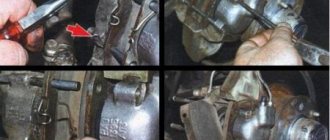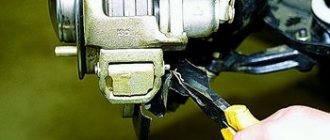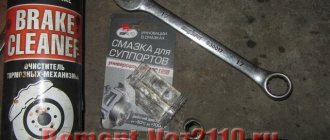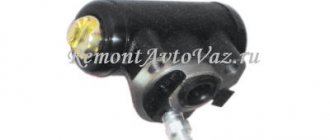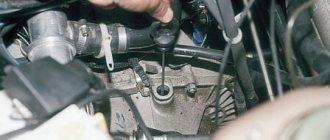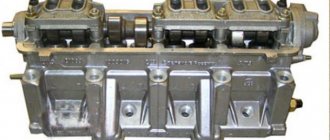Replacing the brake hose. Practical guide.
The order of work performed to replace the brake hose.
The braking system plays an important role in the operation of any vehicle. If at least one of its elements turns out to be faulty, this can lead to disastrous consequences. Therefore, you should be especially vigilant about the serviceability of all elements of this system.
An important component of any braking system is the brake hose. Cracking and wear of brake rubber hoses is a fairly common problem. To prevent this, you need to lubricate it with silicone grease, and also periodically check its serviceability. If there is any suspicion of a defect, you should immediately replace the brake hose, because its malfunction in the future can have a detrimental effect on road users.
1. First of all, the vehicle should be prepared to perform the necessary operations. To do this, you need to place it on a flat surface, install stops under the wheels on the side opposite to the wheel being hung.
For safety reasons, we install chocks under the wheels.
2. Raise the front of the machine using a jack. Place the car on “chocks” to ensure better stability. Use a wheel wrench to remove the wheel.
To access the brake hose, lift the car.
3. Treat all replacement fasteners and threaded elements of the brake system using a special penetrating lubricant. This will ensure that they can be easily unscrewed. This work must be done in advance so that the lubricant penetrates deeper into the joints.
We will take care in advance by covering the threaded connections with this solution.
4. Using pliers, remove the retaining clip from the body bracket brake hose. Holding it with wrench 17 (so that the tip of the brake hose does not move), unscrew the brake pipe fitting using wrench 10.
Using pliers, remove the bracket securing the hose to the body.
5. Pull the brake hose out of the bracket. Make sure that there is a protective cap on the brake pipe from the bleeder fitting. If it is not there, then a brake fluid leak is inevitable. Using wrench 10, unscrew the fastening bolt of the bracket holding the brake hose and remove it.
Prevent brake fluid from leaking from the disconnected hose. Install the rubber cap from the bleeder fitting.
6. Use wrench 14 to unscrew the brake hose mounting bolt and remove it.
We unscrew the bolt that secures the hose using a 14mm wrench.
7. Installation of the new hose must be done in reverse order. It is also necessary to change the copper sealing washers. After installing a new brake hose, you need to bleed the brake system.
Bleeding the brake systems:
1. To bleed the brake system, fill the reservoir with brake fluid to the max level.
Refill the tank on the master cylinder with brake fluid.
2. Next, you need to remove the protective cap from the fitting and put a transparent hose on it, then lower it into the container where the brake fluid is located. This will prevent air from getting inside the brake system.
After replacing the brake hose, be sure to bleed the system to remove air.
3. To bleed the brakes, you can’t do without an assistant. He must press the brake pedal and hold it down. Have an assistant press the brake pedal all the way 3 times. In this case, you must use wrench 10 to unscrew the bleeder fitting.
Unscrew the bleeder fitting with a wrench.
The accumulated air will collect in the barrel of liquid. After this, you need to tighten the fitting, repeating the operation again. You need to repeat until the air leaves the system. 4. As air escapes, you will need to add brake fluid to the reservoir. Upon completion of this operation, screw the bleeder fitting tightly, remove the tube, install the protective cap, and then install the wheel in its original place. To bleed, you need to add fluid of the brand used in your car system.
As you can see, there is nothing complicated about replacing a brake hose. But this work also requires a serious and responsible attitude.
After all, not only your life, but also those of those around you depends on the quality of its implementation. While performing the work, you need to use attentiveness and caution. But personal qualities will not be enough - you also need to have certain skills
If you are unsure of your abilities, then seek help from a service station.
https://remcars.info
Conclusion
Buying a new hose to replace the old one is quite simple - there are many of them on the automotive components market today. And replacing brake hoses is not particularly difficult, although it will require several tools and quite a lot of patience. However, the same work can be done by specialists at a service station. Operating a car with leaking brake hoses is extremely dangerous, so if you discover abnormal brake operation, be sure to check not only the calipers, pads, discs and drums, but also the entire brake line.
Work procedure
Chevrolet Lacetti CDIX Logbook Replacing rear brake discs and pads
Rear brake pipes VAZ 2109
Before you take action, you need to prepare first. During the preparatory work, it is necessary to clean the surface of the fitting tubes from contamination.
You also need to apply a special compound to all threaded connections, this will make it much easier to unscrew the nuts. In addition, you need to prepare a wrench, spare brake fluid for topping up, a small container to drain the remaining fluid from the system and a suitable vinyl tube.
For convenient repairs, it is recommended to install the machine either on an overpass or on a pit for inspection:
- First, use a Phillips screwdriver to unscrew two self-tapping screws that secure the tube to the body of the vase.
- Using a suitable wrench, unscrew the 2 fittings through which the tubes are attached to the hose with the regulator.
- The tube is removed.
- After all necessary work has been carried out, the tubes are installed in the opposite order to dismantling.
- Add brake fluid.
- The quality of repaired brakes is checked.
On newer VAZ models, the tubes are first unscrewed from the main cylinder and brake hose, only after that the holes are plugged. In this case, you will have to unscrew the 3 fastening nuts and remove the plastic covering.
Next, dismantle the metal plates and disconnect the necessary tubes from the clamps; if they are damaged, they will need to be replaced.
Note! New elements must be secured in the opposite order. To check the quality of work, it is necessary to bleed the system. It must be done to eliminate excess air.
Replace the rear brake pipe of a VAZ 2109
Signs of air penetration into the system are considered to be increased travel and softened sagging of the brake pedal when pressed.
It is necessary to follow a certain sequence of bleeding the brakes:
In addition to changing the brake line, the brake hose may also need to be replaced.
When do you need to replace front/rear brake hoses?
The importance of the element necessitates regular checking of its condition for tears or natural wear. Signs that your rear/front hoses need to be diagnosed and replaced include:
- the appearance of cracks;
- abrasions;
- brake fluid leak;
- peeling of the inner part;
- rust of connecting tips and violation of their tightness.
Defects in this element appear due to friction or when foreign objects get inside.
How to change a brake hose
Instructions for Renault Logan, Megan II. Phase 2. Replacing the front brake pads
As a rule, the brake system of any car must be in working order at all times. To prevent cracking and breaking of rubber brake hoses, it is necessary to periodically lubricate them with silicone grease.
Note! If there is even the slightest suspicion of a defect, such elements must be replaced immediately, since the safety of both the driver and passengers will depend on this.
To carry out repairs, it is recommended to buy or acquire:
a size 8 or 10 wrench, which is used to remove brake pipes; wheel wrench; wrench size 17 and 14; transparent vinyl tube; sealing copper washers; well-penetrating lubricant; a container for draining the “old” brake fluid; new fluid, it is recommended to pay attention to the DOT-4 class.
VAZ 2109 brake pipes
Repair work must be carried out in a certain sequence:
- Preparatory actions are being carried out. The machine is installed on a level place, stops are placed under the wheels on the opposite side in relation to the suspended wheel.
- The front area of the machine (right or left) is raised using a jack. To prevent the car from being supported by only one jack, for safety reasons it is placed on blocks.
The wheel can be easily removed using a wheel wrench.
All replaceable threaded and fixing parts of the system are treated with a well-penetrating lubricant, which ensures easy unscrewing. It is advisable to use the lubricant in advance so that it has time to penetrate deeper into the joints.
Fastening brake pipes VAZ 2109
- Using pliers, you need to remove the hose securing bracket, which can be found on the body bracket. Using a size 17 wrench, the hose tip is kept from turning, and a size 10 wrench is used to unscrew the tube fitting.
- The brake hose is removed from the bracket and the protective plug is put on the brake pipe. Such measures are necessary to prevent fluid leakage. Use the 10th key to unscrew the fixing bolt of the bracket holding the brake hose.
- The 14th wrench is used to unscrew the fastening bolt from the brake hose, which needs to be removed. Installation of a new element is carried out in the opposite order.
Note! It is advisable to immediately change the copper sealing washers.
Upon completion of the replacement, it is necessary to bleed the brake system:
For normal bleeding, you need to add fluid to the brake reservoir to the maximum limit. The protective cap is removed from the fitting, a pre-prepared transparent hose is put on it, which is lowered into a container filled with liquid.
Thus, they get rid of air that has entered the brake system.
You can involve an assistant in pumping the brakes; he will press the brake pedal all the way, holding it. Such actions are performed three times.
At the same time, you need to unscrew the bleeder fitting with the 8th or 10th key. If air is present, it will quickly escape into the container.
Note! Bleeding must be repeated until all the air is released. In addition, you need to monitor the level of brake fluid in the reservoir.
With the help of a detailed video and photo, even a non-professional can change the rear brake pipe or hose with his own hands. In this case, detailed replacement instructions, as well as tips and recommendations from experienced craftsmen, will not be superfluous.
If the repair is being carried out for the first time, you need to carefully unscrew and tighten the bolts so as not to damage the threads. In order for tubes and hoses to last as long as possible, you should buy products only from high-quality materials, so it is appropriate to note that the price should correspond to the quality.
Causes of souring
It is quite easy to see the soured element, called the brake pipe. To do this, do not change the brake fluid for a long time and do not carry out any repair and maintenance work related to unscrewing it.
A common component that is stuck on a car engine is associated with temperature loads. Namely, with an increase in the temperature under which a particular unit operates. No questions arise here, since the engine really gets very hot during operation.
But then it is not entirely clear why the tube gets stuck, which sometimes simply cannot be unscrewed. To remove a brake pipe that is strongly stuck to the joints, you can use different methods.
The adhesion in this place is also quite expected. When the braking system operates, the drums and calipers actively absorb energy, generating heat. Because of this, strong heating occurs. But the most important factor is rapid cooling. This is possible when, after active braking and heating of the brake mechanisms, the car falls into a deep puddle or plunges into the snow. This leads to a sharp temperature change.
Additionally, car brake pipes are affected by auto chemicals, chemicals on the roads, dirt and various liquids that end up on the element and in the areas where it is connected to the caliper or cylinder.
It is worth highlighting one more point. Then there is a large volume of water in the brake fluid, and the process of internal oxidation begins. That is, oxidative reactions occur internally, and sticking occurs under the influence of internal provoking factors.
Let us remind you how to check the condition of the brake system without leaving the garage.
Replacing the front brake cylinder of a VAZ 2107
A situation arises when the engine is idling and the gear lever is in neutral. The driver must press the brake pedal and hold it in this position for several minutes. If the pedal falls very easily, then there is reason to suspect that there is a malfunction in the system
You need to think about how to replace brake hoses on a VAZ 2114, which specialist you should trust to solve an important issue. The contents of the master brake cylinder are checked regularly; if the fluid level drops, you need to sound the alarm and take the car to a service station using an emergency light. Even if there is a slight decrease in the level of contents in the tank, this condition can still be considered a sign of wear on the brake system components
This means that you need to decide how to replace brake hoses or pads on a VAZ 2114. If you notice the rapid disappearance of liquid from the barrel in a short period of time, this means that there is a leak, and it is strictly prohibited to drive such a machine. We remind you that depressurization of the system can be internal or external, and the first can only be recognized by the condition of the tank, while the second leaves its traces in the area of the wheel mechanisms.
An important rule for a novice driver is to learn how to check the condition of the hydraulic and parking brakes. It wouldn't hurt to know how to regulate them. And the aerobatics for a newbie in the car industry is to know how to replace brake hoses on a VAZ 2114, especially since this car brand is a debut for many. It is imperative to inspect the condition of the wheels and “adjacent areas” before leaving. If you notice dampness on the surface being inspected, react immediately - check and figure out how to replace brake hoses on a VAZ 2114. Beginners should also study the control panel inside the car. Sensors there are always triggered if any of the important parts are worn out or suddenly fail. Always pay attention to the warning lights of the brake system. So, for example, at the moment the ignition signal is given, the brake warning lamp should be on, and go out when the car starts and starts moving. Then everything is in order and there is no need to think about how to replace the brake hoses on a VAZ 2114 this time.
Why do they sour so much?
There are several reasons:
- They are located next to the wheels of the car. And this is water, snow, dirt and other delights of our roads, that is, a banal external factor
- Warming up calipers and drums. When braking, a lot of heat is generated, so the elements of the braking system can heat up, and after getting into a puddle they can cool down sharply
- Brake fluid is hygroscopic. If it takes up water more than 3.5% of the total volume, then it urgently needs to be replaced. However, even if the proportion is only 2.5 - 3%, then such brake fluid will oxidize metal parts from the inside
These are the most basic points why sticking and souring occurs so strongly.
Some tips on how to replace brake hoses on a VAZ 2110
- An old copper ring can be cleaned with sandpaper and all its surfaces can be leveled.
- When installing a new hose, understand its scope. Firstly, it should not twist when the car makes a turn. Secondly, when maneuvering the car, the hose should not touch the car’s suspension elements, otherwise it will very quickly become unusable.
- If you changed one or two hoses, you can partially bleed the system according to a certain pattern.
- The VAZ 2110 has one feature - to dismantle the rear hose, you need to use the correct keys. For a 10 fitting, use a 15 key.
- Bleeding scheme for the VAZ 2110: the rear left wheel, followed by the front right, the second stage - the rear right, and finally the front left.
- If possible, buy a special wrench for the brake pipe fittings. It may be necessary to make the work easier, especially if the machine is old and requires major repairs.
Keys for brake pipes
Thus, the scheme for replacing brake hoses on a VAZ 2110 is carried out according to the standard scheme, taking into account safety precautions and the structure and contents of the vehicle. There is a difficulty that often arises - the brake hose fastenings cannot always be removed.
How do you deal with such a problem? Do you have experience in repair work and a win-win option for dismantling a brake hose? Share your experience.
Brake hoses made of high-quality material usually have a long service life. Which VAZ 2110 brake hoses are better? Those that are made of high-quality rubber and preferably from a reputable manufacturer.
The reasons why this part fails are as follows:
- The car is not new.
- Its mileage is several tens of thousands of kilometers.
- The car was idle for a long time.
What is needed to replace hoses
In order to change brake hoses on a VAZ 2110, you must have:
- wrench for brake pipe fittings;
- screwdriver;
- wrench.
Where is the part located?
If the car is front-wheel drive, then there will be 2 VAZ 2110 brake hoses located in front and behind it. To get to the front brake hoses, just remove the wheels. In order to find the rear brake hoses, you need to use the inspection hole and unscrew the fastening nuts.
Replacement timing
Every time it becomes necessary to remove the front wheels, it is worth checking the condition of the hoses. There is no set car mileage required for replacement. Although VAZ advises changing them after 125,000 km, or 5 years after operation. But you should understand that the hose can become unusable much earlier. The detail should be monitored. If it shows severe wear, swelling, cracks, or delamination of rubber, the brake hose must be quickly replaced.
Is it worth switching to reinforced brake hoses?
Since most cars have rubber brake hoses, many car enthusiasts wonder if it makes sense to replace them. The answer is simple: yes, but only if driving conditions allow it. Rubber hoses make the brake system more inert and noticeably less informative - it can be difficult for the driver to understand how quickly the system will respond to pressing the pedal. At the same time, in conditions of measured driving around the city, this disadvantage of rubber hoses is practically not felt.
Reinforced hoses are strictly recommended for those who prefer aggressive driving and own a sports car. With such hoses, the brake absorbs the force from the pedal a little better and, accordingly, becomes more predictable. An experienced sports car driver can estimate how hard the pedal should be pressed in a given situation. In addition, the modified system will perform much better during emergency braking. A series of tests showed that a motorcycle traveling at a speed of 150 km/h reduced the braking distance during emergency braking by 15-30 m after installing reinforced hoses. The car will show a similar result - the braking distance will decrease.
It should be noted that reinforced hoses are highly resistant to mechanical and chemical influences. If the car is operated in particularly difficult road and weather conditions, reinforced brake hoses are strictly necessary. The above-mentioned emergency braking can also be classified as severe conditions if they occur quite often.
To summarize, we note that reinforced hoses are indeed superior to standard rubber hoses in all respects . But there are many cases where their installation and further operation did not end well. Firstly, such hoses are known to fray. Secondly, if you brake suddenly, the hose may burst. The first option is associated with incorrect installation of the element. The reason for the second situation is the installation of a hose that is not suitable for the car. For example, an item from an American auction for an American car may be suitable for European or Asian vehicles, but in reality the compatibility is not complete. Choosing the right reinforced brake hose for your vehicle can be difficult, and in some cases, impossible.




